�
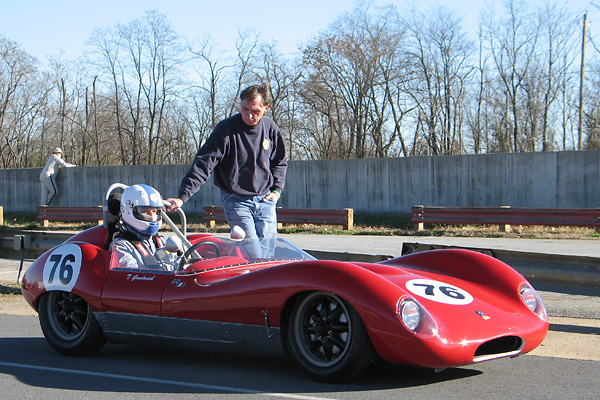
�
Tom Grudovich's 1960 Lola Sports Mk.1 Race Car
� � Owner: Tom Grudovich� City: Palm Beach, Florida
� Model: 1960 Lola Sports Mk.1
� Engine: Coventry Climax FWB (1460cc)
� Race prepared by: Michael Clifford and Larry Thew�
�
Eric Broadley, Lola Cars Ltd., and the Mark One Model
��
Eric Broadley designed and prototyped his Sports racing car in 1958 before founding a �
company to manufacture it. The new car was only the second he'd ever built. In designing �
it, Broadley focused on challenging Lotus Engineering in the small bore sports racing �
classes they had dominated for two years with their �
Eleven and �
Eleven Series Two models. Small displacement sports racing classes had become very popular,�
largely due to the Lotus Eleven's merits. Lotus Engineering's success demonstrated that �
these classes presented a ready and profitable market, and a good stepping stone toward �
more prestigious classes - not just for racers, but also for constructors. �
�
Like the Lotus Eleven, the Lola Sports was designed around the Coventry Climax FWA �
engine. Eric Broadley believed he could beat Lotus at their own game by creating a �
sports racer with smaller frontal area, superior rear suspension, and lower overall �
weight. We don't have accurate measurements with which to quantify and compare �
crossection or coefficient of drag, although the Lola appears smaller in profile. �
The Lola Sports does have a particularly effective independent rear suspension, which �
is at very least equal to the Lotus Eleven DeDion suspension (and it certainly has �
less unsprung weight). Depending on customer specification, the car typically weighed �
810 to 840 pounds, which is about a hundred pounds less than a comparably specified �
Lotus Eleven. Lotus engineer Michael Costin included a glowing detailed analysis of �
the Lola Sports in his book Racing & Sports Car Chassis Design and particularly �
praised its frame: "with a stiff, well-designed chassis, it could well go down to �
posterity as one of the classic cars of the post-war era."�
�
Broadley soon proved out his ideas on the racetrack, finishing second at Snetterton �
in the prototype's second race. He followed up immediately by winning at Brands Hatch �
with a 24 second margin of victory. The Lola prototype was the first sportscar to lap �
the Brands Hatch club circuit in less than one minute. Frankly, few people attributed �
Broadley's racing success to his driving: his car was obviously superior, right out �
of the box. �
�
Then Lotus made a bad mistake. They reacted to Broadley's success by throwing together�
their answer too quickly. The Lotus Seventeen model looked good on paper, and even in �
real life when parked. It featured an even lower and lighter design, plus an all�
wheel independent suspension featuring Chapman struts. However, it was undeveloped �
when they introduced it and its front suspension design quickly proved dangerously�
flawed. Due to unpredictable handling, Lotus requested that customers bring their �
Lotus Seventeen race cars back so an entirely different front suspension could be �
retrofitted. (Nineteen of the twenty customers complied.) Whether the suspension �
redesign fixed the problem is almost immaterial, the debacle had underlined the Lola �
Sports' reputation as THE sports racing car of 1959. �
�
Success continued on the racetrack too, of course. Lola Mark Ones swept first, �
second and third place in the 1959 Chichester Cup at Goodwood, and they scored a �
victory at Clermont-Ferrand as well as taking a class win in the RAC Tourist �
Trophy. In 1960, Lola Mark Ones finished first and second in the Autosport Sports �
Car Championship's 1150cc class. (They repeated this victory in 1961.) Privately �
entered Lola Mark Ones took class wins at the Sebring 12 Hours and the �
Nürburgring 1000km in both 1960 and 1961. �
�
The Lola Mark One model accomplished just about everything Eric Broadley could�
have hoped for it. It established his reputation as one of the keenest car designers�
in the world, while assuring the viability of his new company. The Mark One might �
have been even more commercially successful if its introduction could have come a �
little sooner, because the newly introduced Formula Junior class did cut into �
the popularity and growth rates of the Sports classes. Soon, Lola would introduce �
their own Formula Junior. The new Lola Cars company would never grow into as large �
a concern as Lotus, but it did endure forty years and produce over a thousand cars, �
spanning nearly every high level racing class. �
�
The Lola Heritage register recognizes thirty-four original, serial-numbered "Lola Mk1" �
cars from the first prototype of 1958 to the end of series production in 1962¹. �
�
�
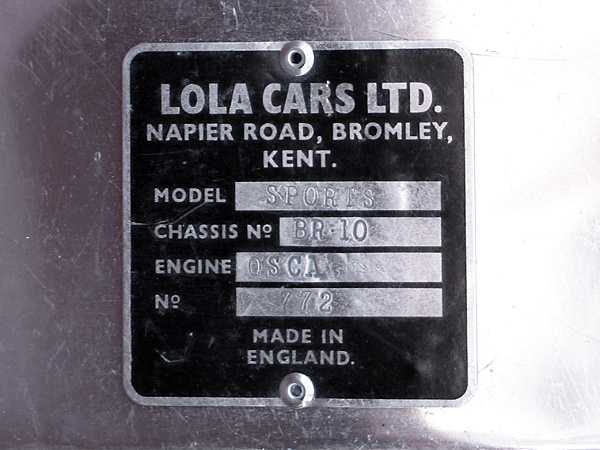
�
LOLA CARS LTD., Napier Road, Bromley, Kent.
�
Model: Sports - Chassis: BR.10 - Engine: OSCA - No. 772
�
Made in England.
�
 �
�
�
�
Tom Grudovich's Lola Mark One
��
Of all the original Lola Sports Mk.1 cars, chassis number BR-10 is exceptional: it was �
built to unique specifications, it had a particularly successful racing career, �
and it's now been restored to absolutely pristine condition for vintage racing. �
�
BR-10 was specially built for Oliver ("Ollie") Schmidt, a Volkswagen/Porsche dealer �
from Chicago who was already one of the quickest drivers in SCCA's 750cc "H-Modified" �
class. When Schmidt read about the new Lola, he quickly came to the conclusion it �
might also excel in the H-Modified class, so he arranged a visit to the new Lola �
workshop. Upon confirming his initial impression, he wrote out a special order �
for a Lola Mk.1 to be powered by an OSCA 750cc engine².�
�
Schmidt's new OSCA engine arrived at the Lola workshop in January 1960. When it �
arrived, the Lola staff found it more different from a Climax engine than they'd �
anticipated. OSCA had newly re-engineered their dual overhead cam cylinder head with �
carburetion on the left and exhaust on the right (i.e. flipped 180 degrees from �
their earlier design. The Climax FWA engine has both induction and exhaust on the �
lefthand side.) The chassis Lola had started building for Schmidt was exchanged for �
a different one. Chassis number BR-10 needed to be built with a few special design �
modifications to suit the OSCA engine.�
�
�
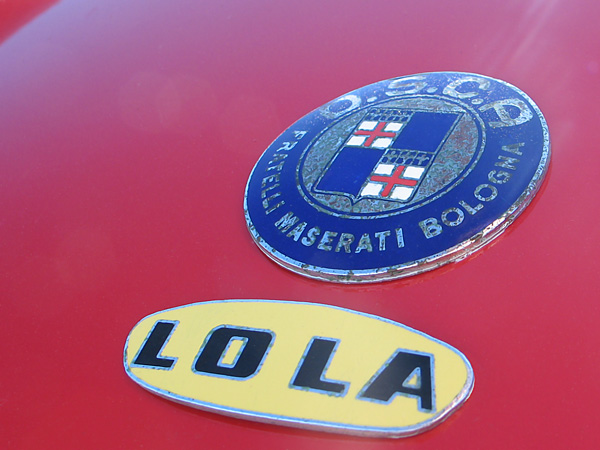
�
Ollie Schmidt's one-of-a-kind Lola-OSCA dominated SCCA H-Modified racing in the 1961 season.
�
Schmidt won eight victories in ten races to easily secure the Championship.
�
�
Schmidt's original OSCA S187N engine had a 64mm bore and 58mm stroke for a �
displacement of 745.9cc. Its static compression ratio was about 9.5:1. �
In 1963, SCCA raised the displacement limit for their H-Modified class from �
750 to 850cc, so the engine was bored to 68mm for a new displacement of 843cc. �
Weber 33DS twin-choke carburetors were used through its racing career.�
�
For the 1962 season, Ollie Schmidt sold the Lola-OSCA and moved up to G-Modified �
with a new 1100cc OSCA powered de Tomaso. New owners John Holmes and Guy Bates took �
the Lola-OSCA to fourth place in 1962 SCCA H-Modified standings with Holmes driving,�
and fourth place in the northeast region with Bates driving. The two owners also �
raced their 750cc Lola-OSCA throughout the 1963 season. They were somewhat less �
successful because SCCA increased the H-Modified displacement limit to 850cc. In �
autumn 1963 they rebuilt the engine with enlarged cylinder bores so they could �
continue racing it for several more years. At about this time, the H-Modified class �
was replaced by the D-SR class.�
�
In 1968, the Lola-OSCA was sold to Larry Green and M.P. Valsainer. They logged �
occasional race victories, including a first-in-class finish by Green at SCCA's �
1969 June Sprints. �
�
Early in the 1970s, the Lola-OSCA's ownership transferred to Francis Ginther. Ginther �
wasn't a driver, but he appreciated the car's unique qualities. He dismantled �
and carefully preserved it, and kept it tucked away for over 30 years. Finally, under �
the new ownership of David George and Henry Petronis, the Lola-OSCA was reassembled �
in 2006. They had the OSCA engine rebuilt using �
new-old-stock spares that had been stored with the car. It was shown at the 2007 �
Amelia Island Concours d'Elegance and then put up for sale. �
�
It's a shame when race cars are condemned to museums, and even worse when they're �
hidden away in private collections. Thankfully, Lola Mk1 number BR-10 has escaped �
those fates. We applaud Tom Grudovich for purchasing the car to sensibly enjoy it! �
We're looking forward to seeing Tom racing head-to-head with some of Lola's �
traditional rivals.�
�
Since the original OSCA engine is irreplaceable in its own right, and also quite �
expensive to maintain, it's been tucked away for safe keeping. A Coventry-Climax �
engine was relatively easy to retrofit because it's the engine the Lola Sports �
(Mk1) was designed around. Furthermore, it's a much more suitable engine for vintage �
racing because there simply isn't much competition anymore for a car under 750cc �
to race against. With a Coventry Climax FWB engine (1460cc), the Lola and its driver�
will get to prove themselves against suitably tough competition. Of course, the �
OSCA engine can be reinstalled at any time. �
�
We saw and photographed the newly re-engined Lola Mark One on its very first �
shakedown weekend. We hope you enjoy our exclusive photos!�
�
Features and Specifications
�| Engine: | �Coventry Climax FWB engine, rebuilt to 1460cc with forged pistons and Carrillo rods.�
(Static compression ratio is about 13:1.)�
Kent Performance Cams camshaft. �
Dual Weber 40DCOE18 carburetors on fabricated tubular steel intake manifolds.�
K&N air filters.�
Lucas distributor with breakerless electronic igntion module, NGK spark plugs and �
Accel HiTemp Super Stock 7mm suppression core spark plug wires.�
Lucas Sport ignition coil.�
K&N oil filter on Moroso remote filter mount. | �
| Cooling: | �original copper/brass radiator.�
Oil cooler. | �
| Exhaust: | �custom long primary four-into-one header.�
Glass pack muffler. | �
| Transmission: | �Taylor Race Engineering Series 26 "Sprite" dog-ring 4-speed gearbox. �
Tilton 7.25" clutch.�
Wilwood master cylinder. | �
| Rear End: | �B.M.C. differential gear carrier assembly, housed in a Lola cast magnesium housing.�
3.90:1 gears and limited slip differential. | �
| Front Susp.: | �wide-based fabricated double wishbones with Morris Minor uprights and a B.M.C. steering rack.�
Carrera (QA1) coilover shock absorbers and springs. | �
| Rear Susp.: | �QA1 coilover shock absorbers and springs. | �
| Brakes: | �(master) Wilwood dual master cylinders with bias bar. � (front) Al-fin 10" by 2.25" turbo-finned alloy drums, Triumph TR2 (later 10") twin leading shoe brakes. � (rear) inboard Al-fin 9" by 1.75" radially-finned alloy drums, Triumph TR2 (earlier 9") twin leading shoe brakes. | �
| Wheels/Tires: | �Cooper magnesium 15x5 eight spoke wheels with Dunlop Racing 204 (hard) compound tires (4.50L-15 front, 5.00L-15 rear). | �
| Electrical: | �CarQuest lead acid lawnmower battery. | �
| Instruments: | �(left to right)�
Autometer Sports Comp oil temperature gauge (140-280F),�
Autometer Sports Comp oil pressure gauge (0-100psi),�
Stack tachometer (0-8000rpm),�
Autometer Sports Comp coolant temperature gauge (140-280F). | �
| Fuel System: | �ATL five gallon fuel cell. Facet solid state fuel pump. �
Holley fuel pressure regulator with "RED" 0-15psi fuel pressure gauge. | �
| Safety Eqmt: | �hybred RaceQuip/Simpson cam-lock five point safety harness.�
Quick release steering wheel hub on a RaceTech Design Ltd. steering wheel.�
FireBottle (Dupont FE-36) 5# centralized fire extinguisher system.�
| �
| Racing Class: | �SCCA H-Modified (originally). SVRA 4/FM (currently). | �
Engine Installation
��
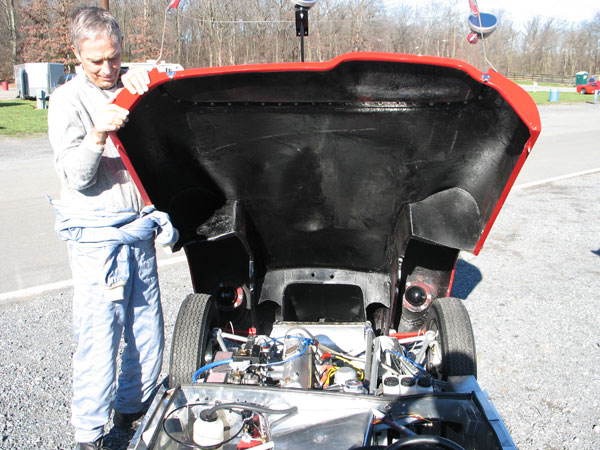
�
Tom holds open the bonnet of his Lola Sports Mark One race car.
�
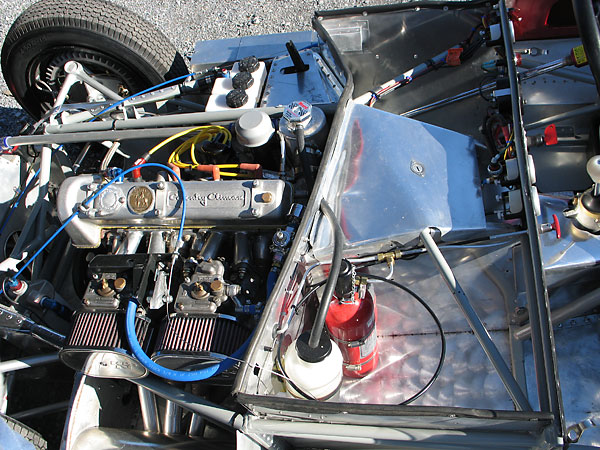
�
The Lola Mark One's assymetrical spaceframe adds to a general impression of complexity, but more
�
careful inspection reveals that nothing is redundant. The structure is remarkably stiff and efficient.
�
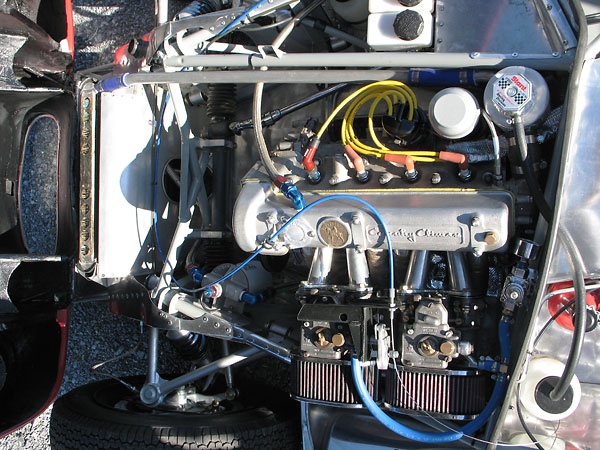
�
Coventry Climax FWB engine (1460cc).
�
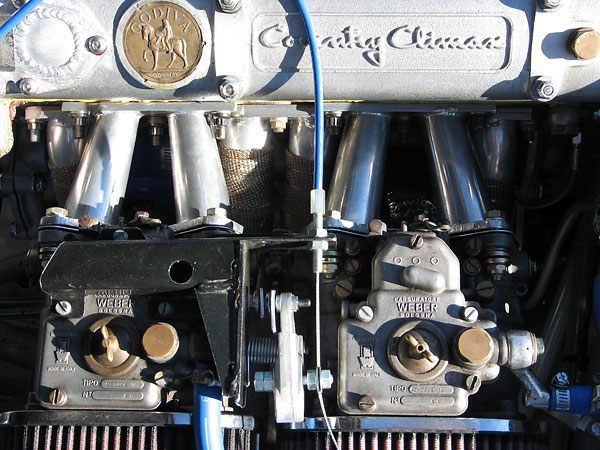
�
Dual Weber 40DCOE carburetors on fabricated tubular steel intake manifolds.
�
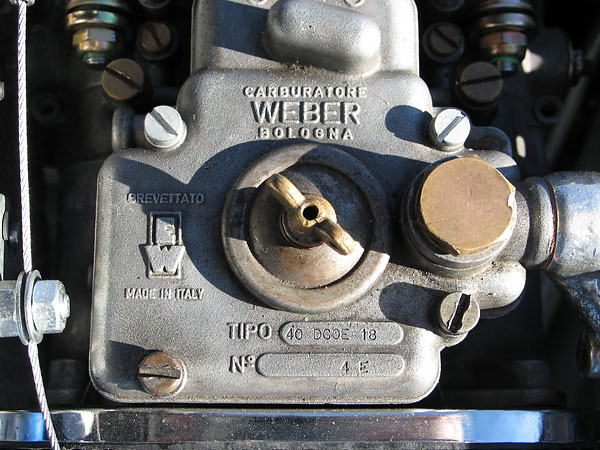
�
Carburatore WEBER Bologna, Brevettato Made in Italy, Tipo: 40 DCOE 18, No. 4E
�
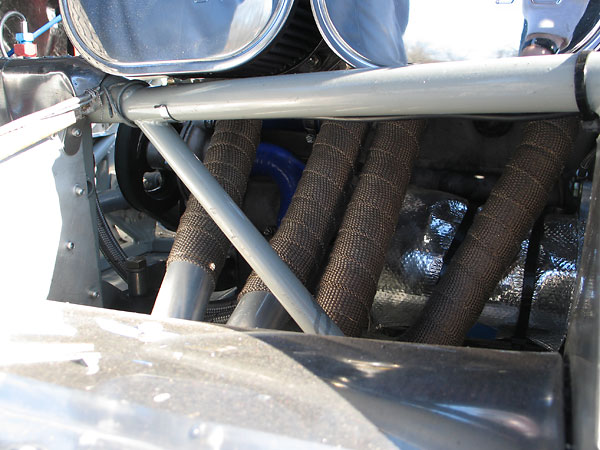
�
A custom exhaust header routes down from under the carburetors. On the original OSCA engine installation,
�
the exhaust routed down and out on the opposite side of the car through very long-primary tri-y headers.
�
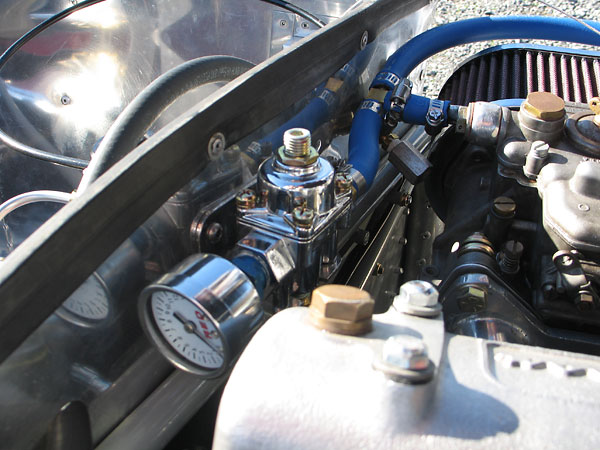
�
Holley fuel pressure regulator with RED 0-15psi fuel pressure gauge.
�
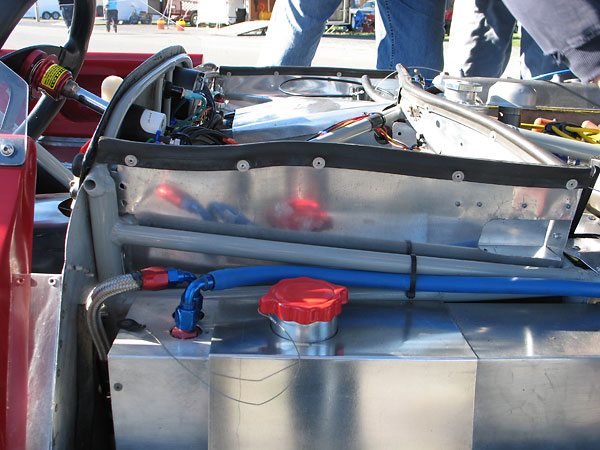
�
The Lola came standard with one 5.5 Imperial gallon fuel tank mounted outboard of the footbox, strapped
�
down with bungies. A second fuel tank could be ordered and easily installed outboard of the opposite foot
�
box. Here, a custom ATL fuel cell has been installed. It's longer than original, and extends further forward.
�
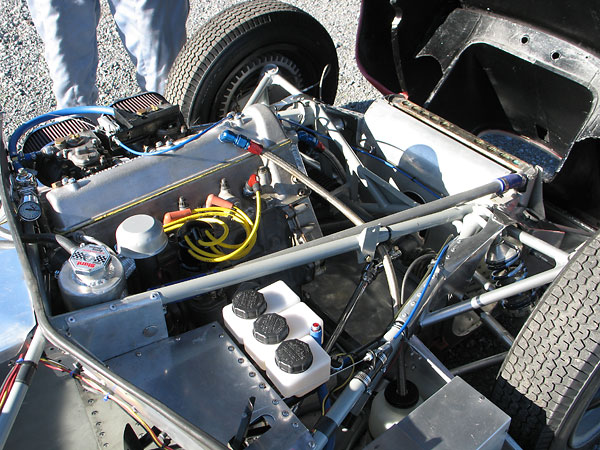
�
Lucas distributor with breakerless electronic igntion module, NGK spark plugs and
�
Accel HiTemp Super Stock 7mm suppression core spark plug wires.
�
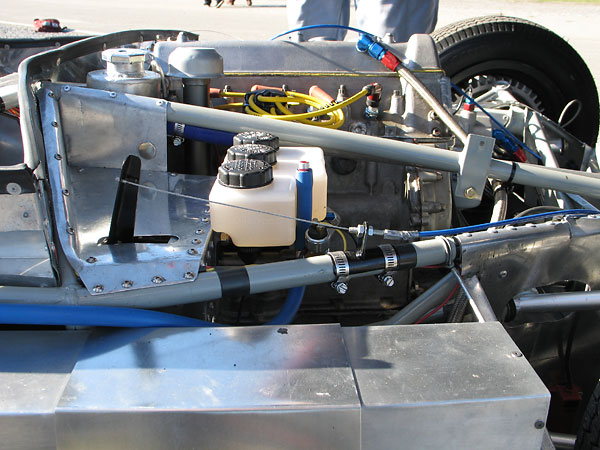
�
The throttle pedal extends through the top of the footbox, but the original Lola-OSCA pedal didn't.
�
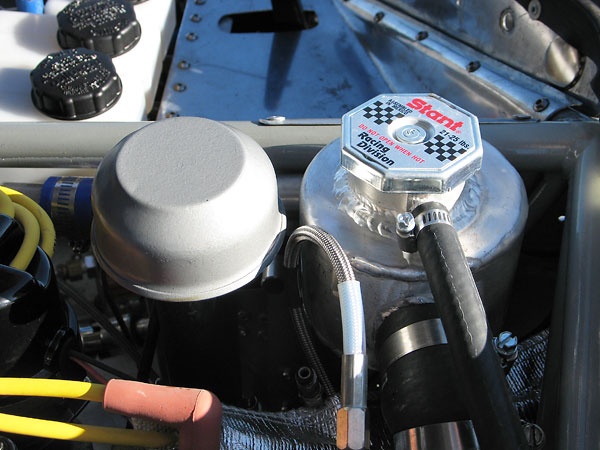
�
Custom fabricated aluminum coolant header tank with Stant Racing Division 21-25psi pressure cap.
�
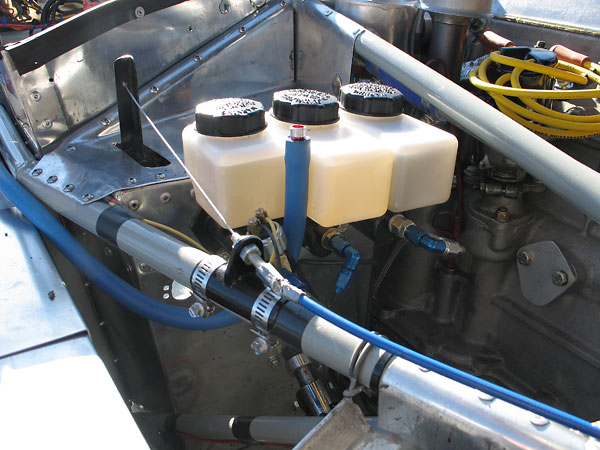
�
Wilwood dual master cylinders with bias bar. (The car originally had Lockheed master cylinders.)
�
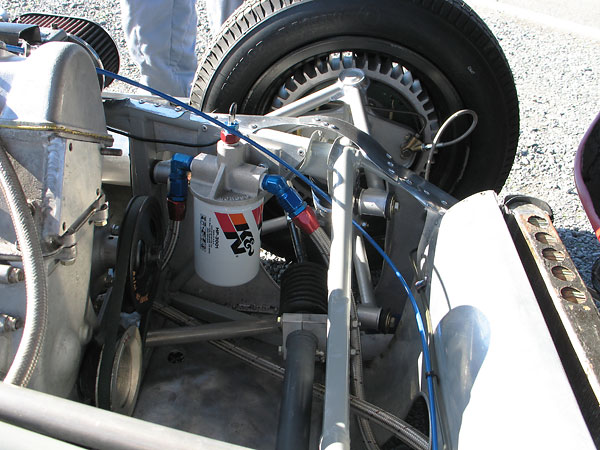
�
K&N oil filter on Moroso remote filter mount. You can see that the braided stainless lines route to an
�
oil cooler. Lola offered oil coolers, but suggested they were "quite un-necessary for Climax engines".
�
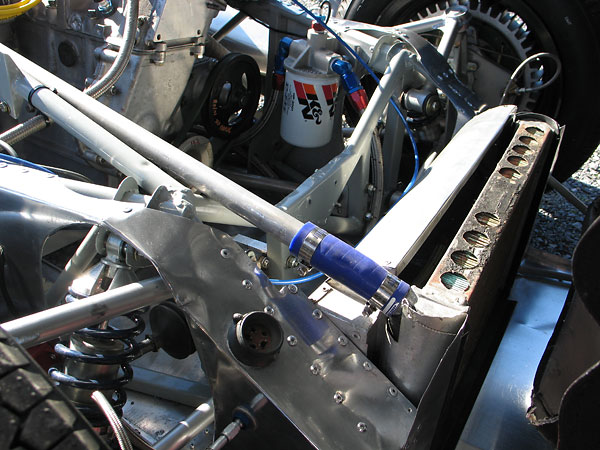
�
Foreground: a multi-pin connector provides a convenient disconnection point for the headlights.
�
Right: the radiator and its ductwork appear original.
�
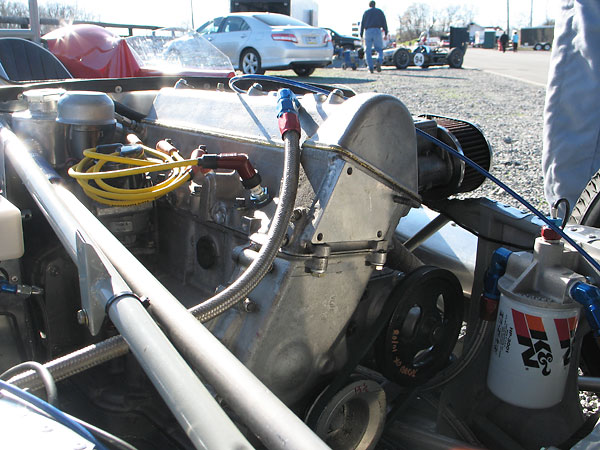
�
The vertical bracket on the long frame tube at left was originally for mounting an ignition coil.
�
�
Front Suspension
��
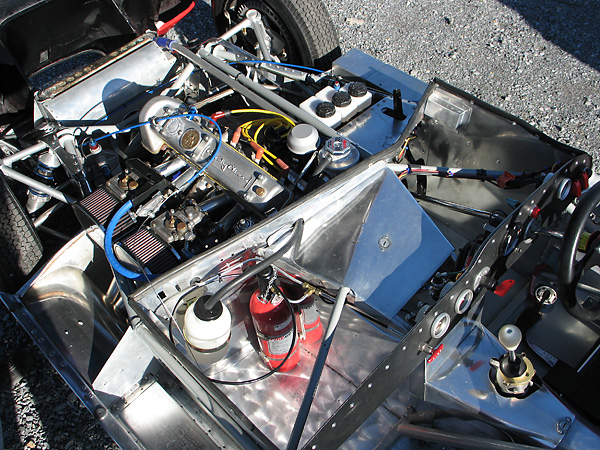
�
The Lola chassis appears complex. Indeed it is, with up to eight tubes coming together at some nodes.
�
However, its sixty pound frame provides remarkable rigidity and feeds loads progressively through well
�
supported and triangulated structures. Complex to build, but effective and quite easily serviceable too!
�
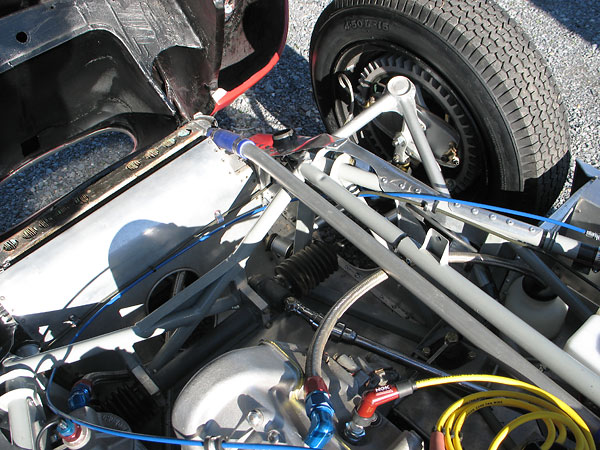
�
The frame was built from a mix of round and box section tubing - mostly in very thin 20 gage steel.
�
Generally round tube was used for the more "pure" parts of the space frame because round tubes are
�
superior at bearing torsional loads, but box tubing performs better where a tube must resist bending
�
from a load applied along its span. An example of this is where the front wishbones connect to the
�
frame. Incidentally, in this example the box sections are reinforced with welded-in through bushes.
�
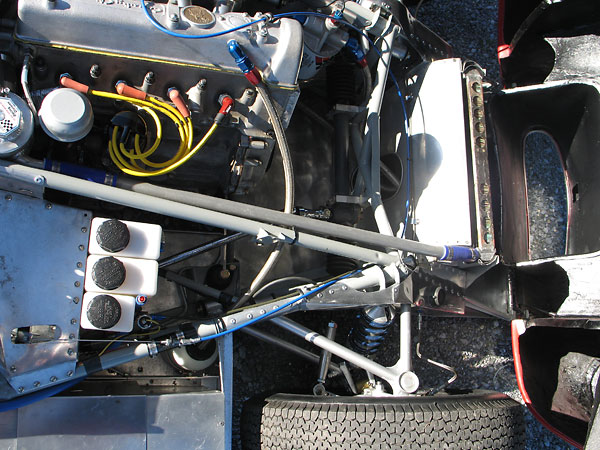
�
Low temperature bronze welding (not to be confused with "brazing") was used for all frame joints and for
�
most other fabricated steel parts. This joining technique has become rare because it requires too much
�
time and skill, but done properly it results in exceptionally fatigue resistant joints with very minimal
�
distortion over the structure. Lola greatly stiffened the chassis through extensive use of stressed
�
aluminum skins including the engine compartment under-tray, the floorpan, etc.
�
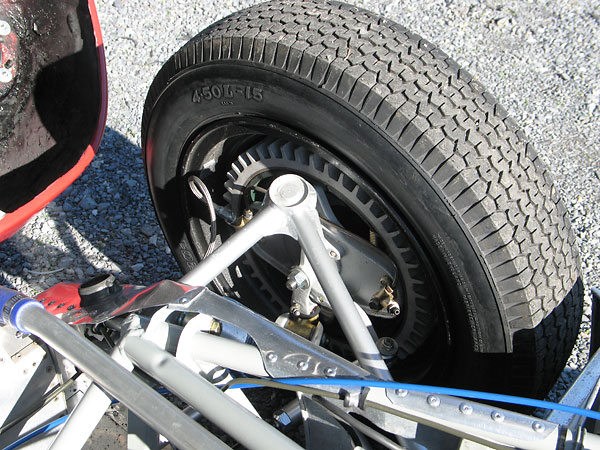
�
Lola used Morris front uprights, with Triumph (late-TR2) 10" by 2.25" twin leading shoe brakes
�
within Al-fin turbo-finned drums. The hub was cast as an integral part of the Cooper magnesium wheel
�
and therefore no separate hub was necessary unless customers specified cheaper pressed steel wheels.
�
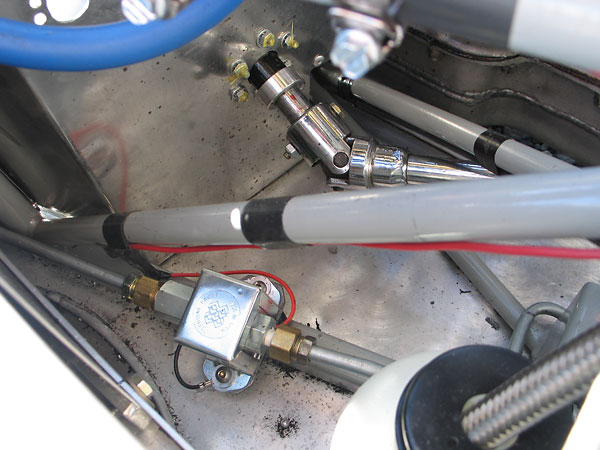
�
The Lola was originally equipped with an S.U. electric fuel pump. At some point it was converted to dual
�
Bendix pumps mounted on the firewall by the carbs. Now it uses this lightweight Facet solid-state pump.
�
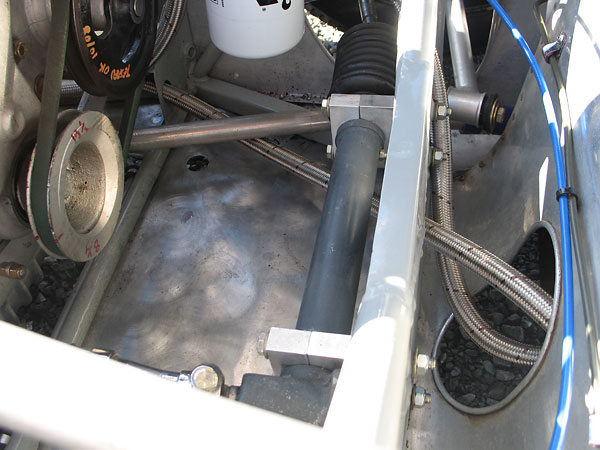
�
B.M.C. steering rack.
�
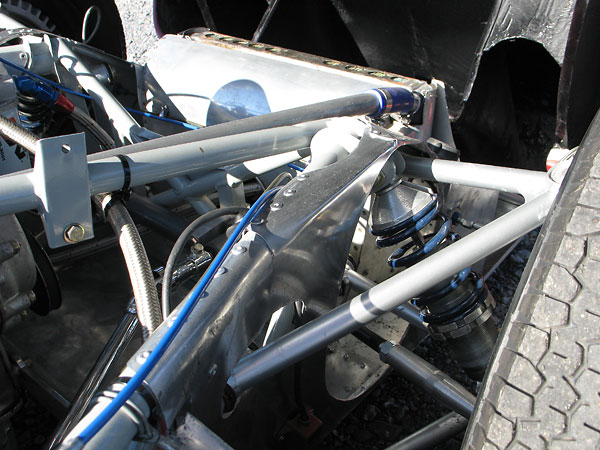
�
Carrera coilover shock absorbers and springs. (Carrera was bought by QA1 and is now one of their brands.)
�
�
Enjoying this article? www.BritishRaceCar.com is partially funded through generous support from readers like you!
�
To contribute to our operating budget, please click here and follow the instructions.
�
(Suggested contribution is twenty bucks per year. Feel free to give more!)�
Rear Suspension
��
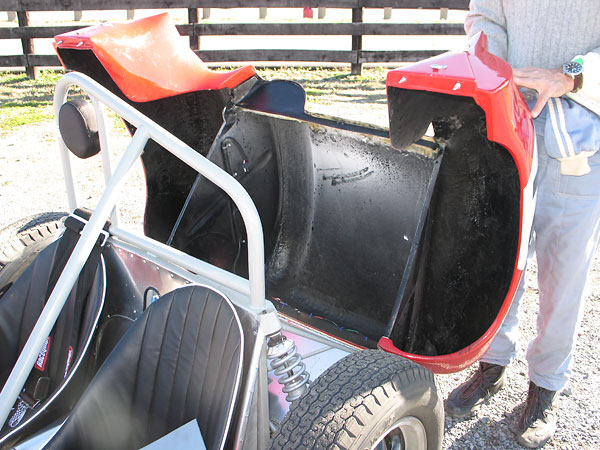
�
According to Lola literature: "The tail contains sufficient room for the carrying of a spare wheel and
�
still leaves room for adequate luggage space to conform with F.I.A. Appendix C requirements."
�
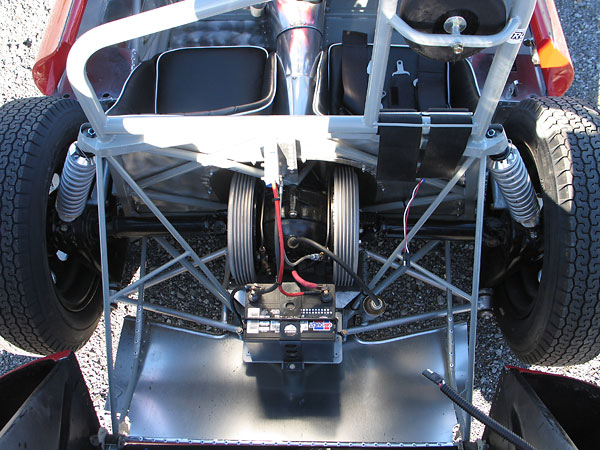
�
Independent rear suspension with double wishbone geometry using the driveshafts in combination with upper
�
trailing arms as de facto upper wishbones. Wide-base lower wishbones (behind the hub carriers) are used in
�
conjunction with steady arms (ahead) to maintain accurate wheel alignment.
�
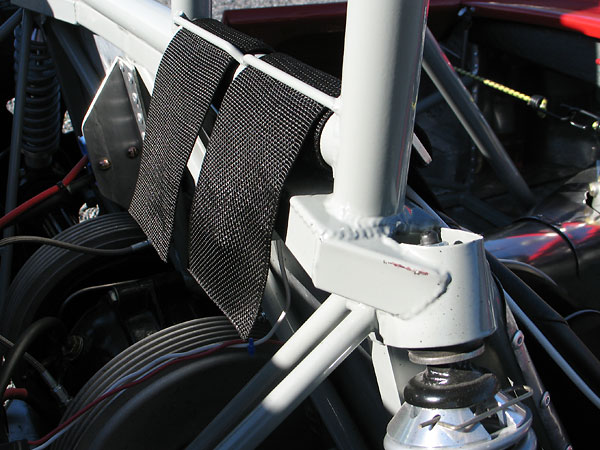
�
The roll structure's large diameter tubes of thick gage seamless tubing meet modern safety rules.
�
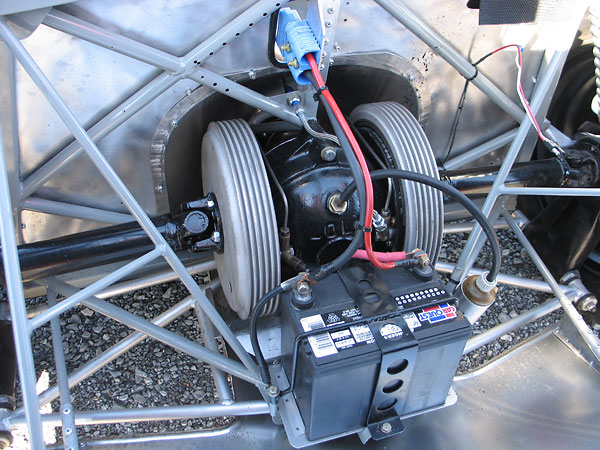
�
Lola designed a custom magnesium casting to house a regular B.M.C. differential gear carrier assembly.
�
Racers could choose between 3.7, 4.2, 4.5, 4.875, and 5.375 to one gear ratios.
�
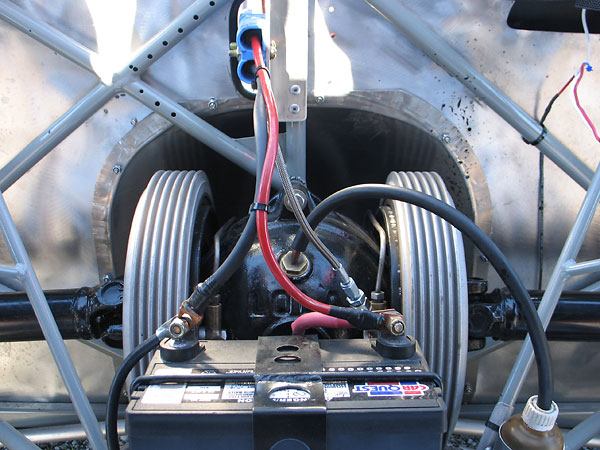
�
Three bolts mount the differential housing to the frame. A breather is incorporated into the oil filler plug.
�
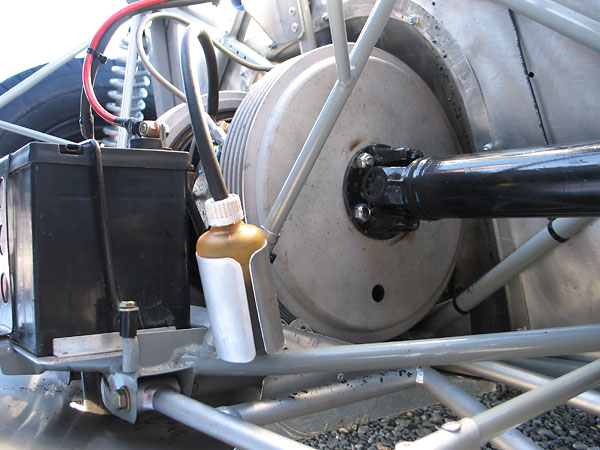
�
Inboard mounted Al-fin 9" by 1.75" radially-finned alloy drums, twin leading shoe brakes.
�
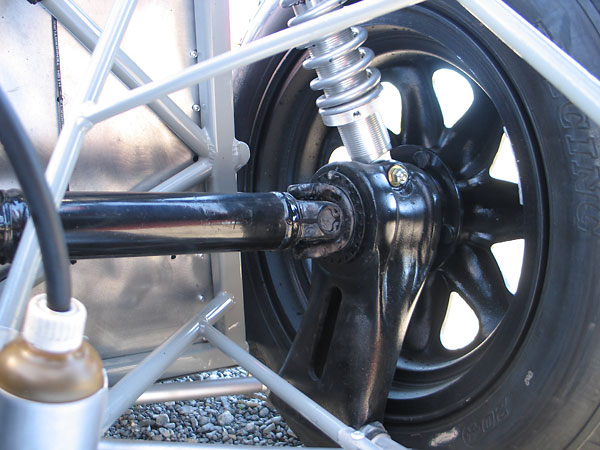
�
Sturdy cast magnesium hub carrier.
�
Use of eccentric joints³ allowed fine adjustments of both camber and toe-in.
�
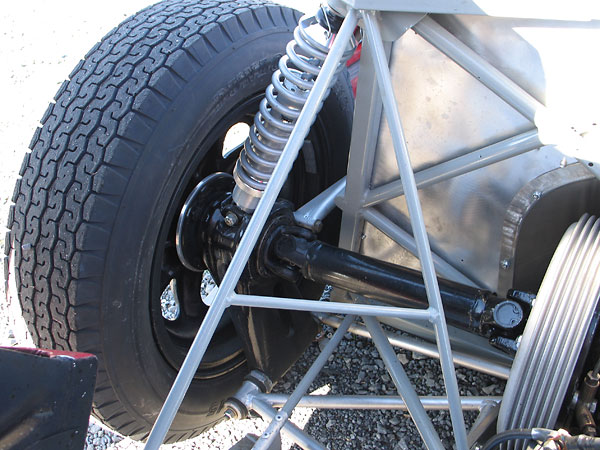
�
The original Armstrong telescopic hydraulic dampers with co-axial springs have been replaced with
�
modern QA1 coilover shock absorbers. Rear suspension pivots are either Silentbloc or nylon bushes.
�
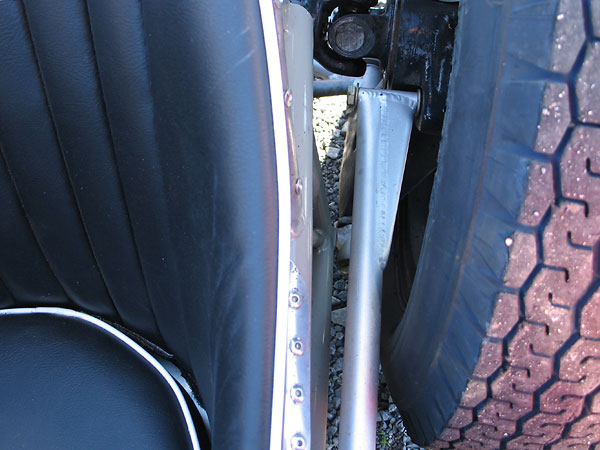
�
The trailing arms are nice and long, but their length isn't adjustable and they're mounted
�
in single-shear at both ends.
�
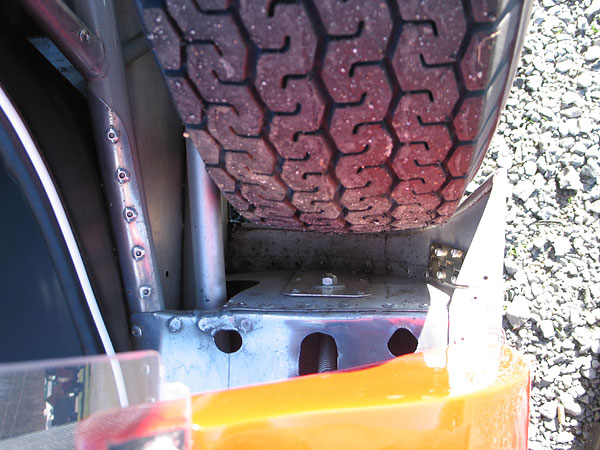
�
Little doors that facilitate changing rear tires are one of the quirkiest Lola Mark One features.
�
�
Interior
��
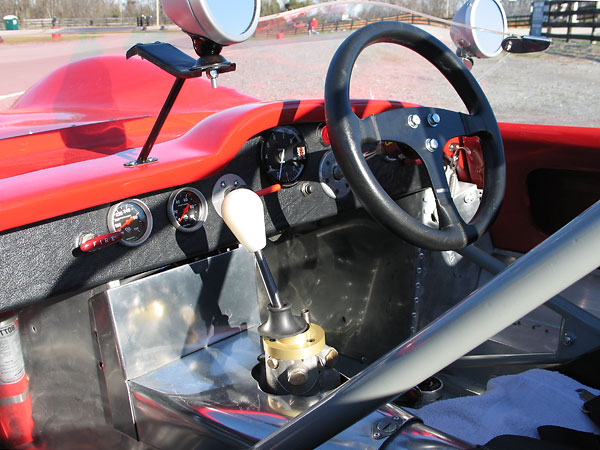
�
Lola Mark One interior and dashboard.
�
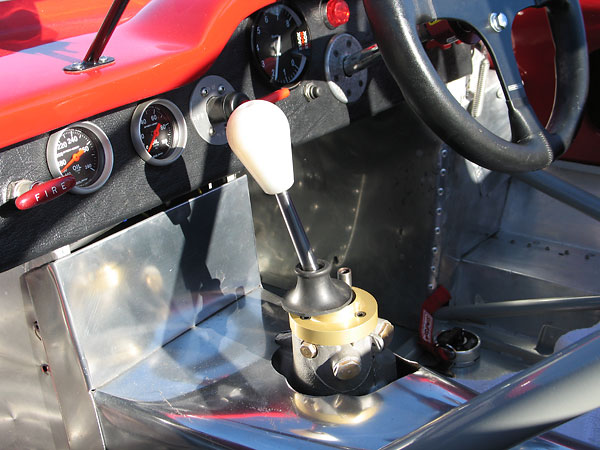
�
The distinctive shifter of Taylor Race Engineering's (Series 26) Austin Healey Sprite dog-ring gearbox.
�
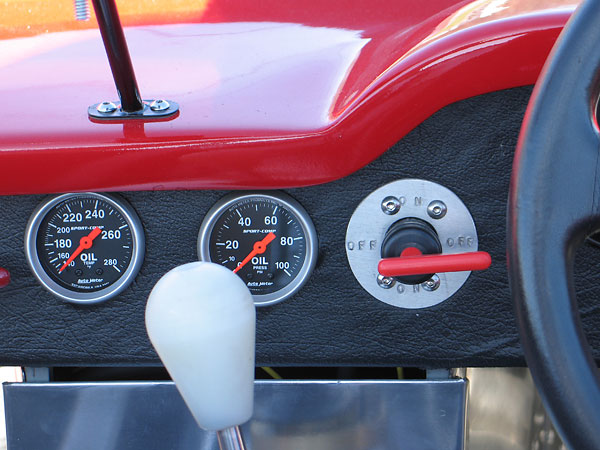
�
Autometer Sports Comp oil temperature gauge (140-280F) and oil pressure gauge (0-100psi).
�
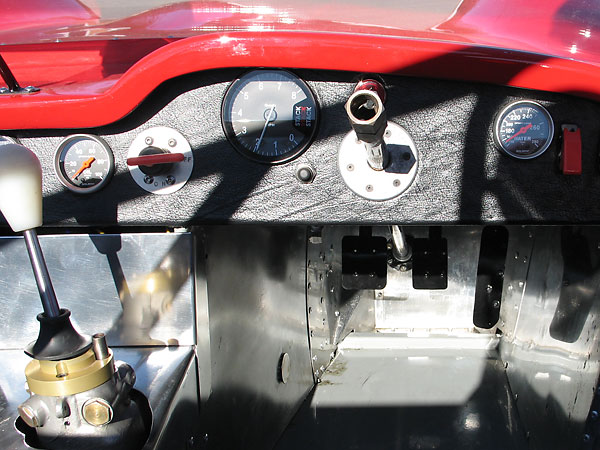
�
Stack tachometer (0-8000rpm) and Autometer Sports Comp coolant temperature gauge (140-280F).
�
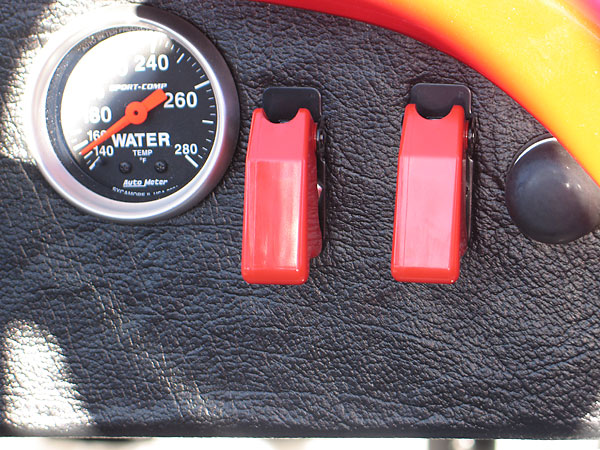
�
Ignition and fuel pump toggle switches, with safety covers.
�
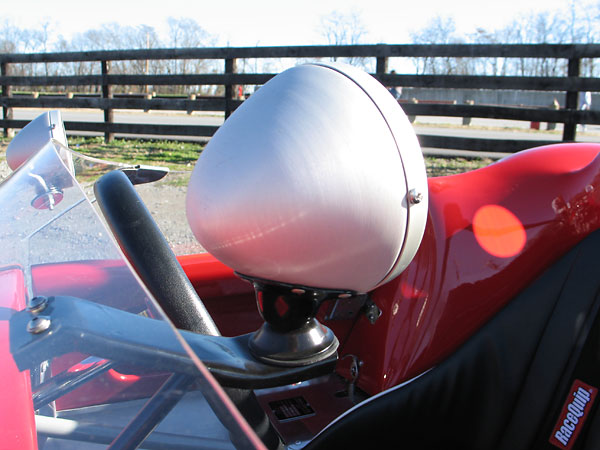
�
GT Classic mirrors are reproductions of the classic Raydyot design.
�
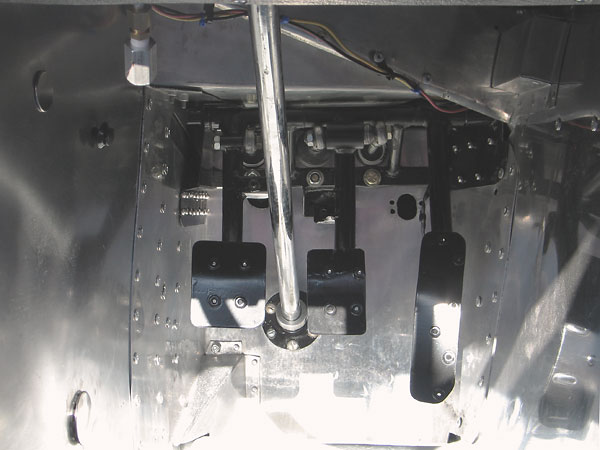
�
Pedals are original, but the way they attach to master cylinders and throttle cable has been updated.
�
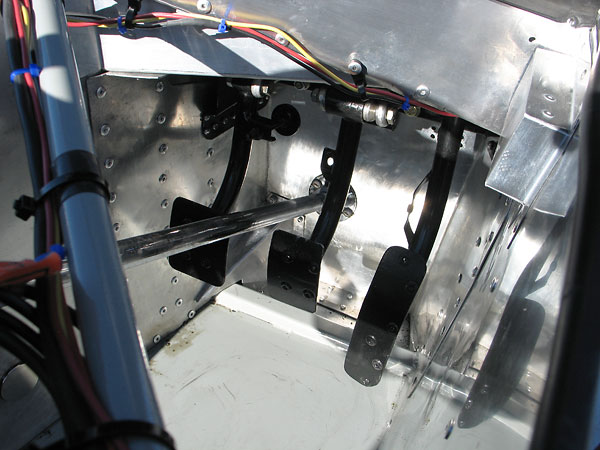
�
Lola Mark One pendent-mounted pedal detail.
�
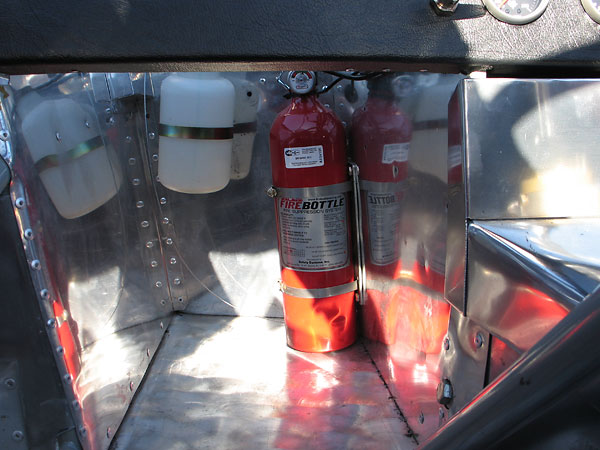
�
FireBottle (Dupont FE-36) 5# centralized fire extinguisher system.
�
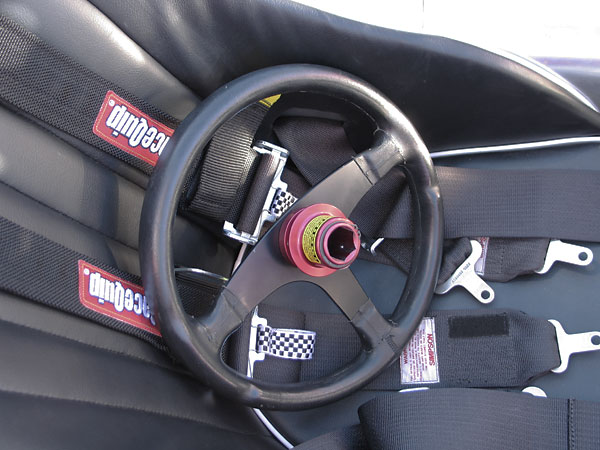
�
The Lola came standard with a leather wrapped 14" alloy steering wheel. This RaceTech Design steering
�
wheel is a nice British-made replacement. Its quick release hub is an important safety feature.
�
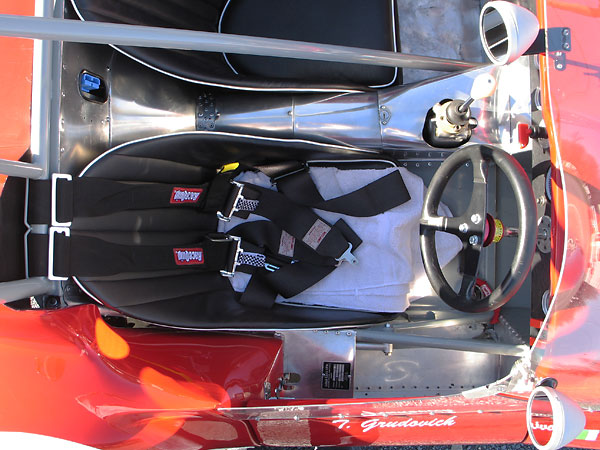
�
RaceQuip shoulder straps used in combination with Simpson lap belts and camlock mechanism.
�
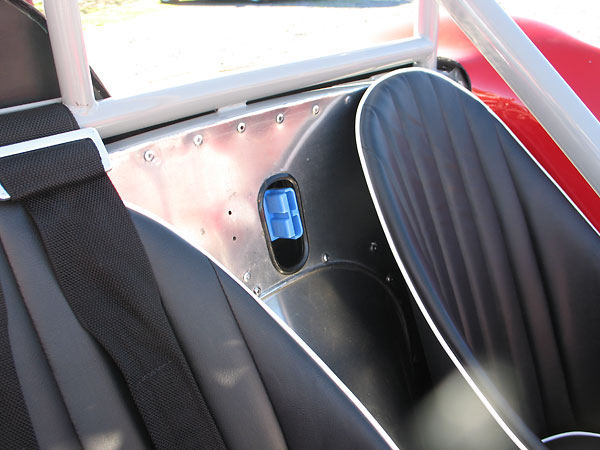
�
Quick disconnect plug for the battery charger.
�
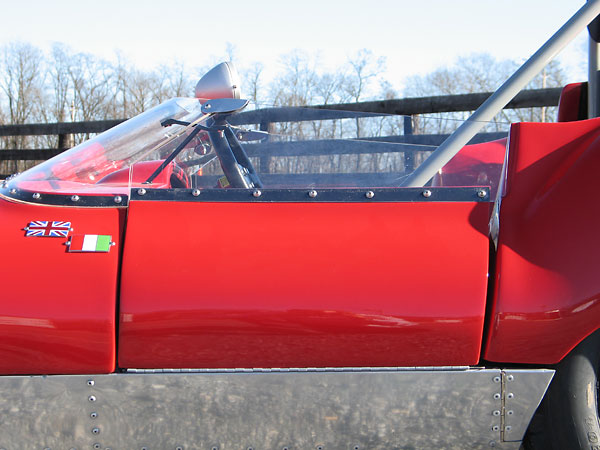
�
Lola Mark One door and door hinge detail.
�
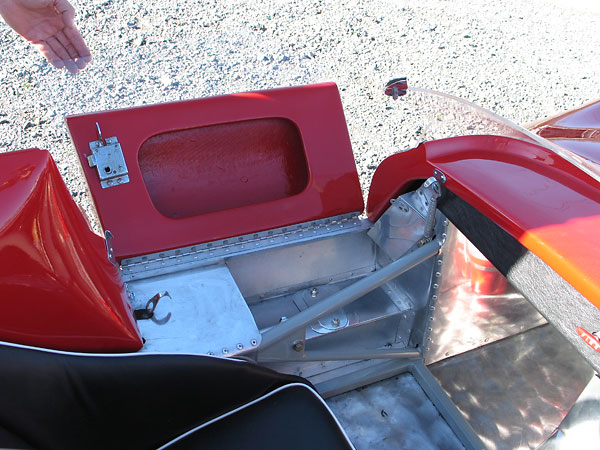
�
Lola Mark One door in half-open position.
�
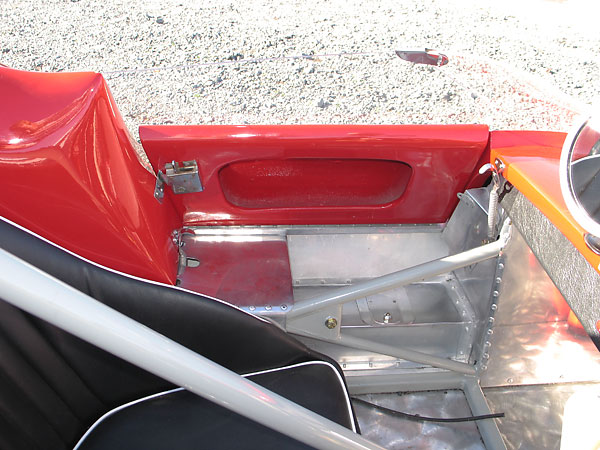
�
Lola Mark One door in latched position.
�
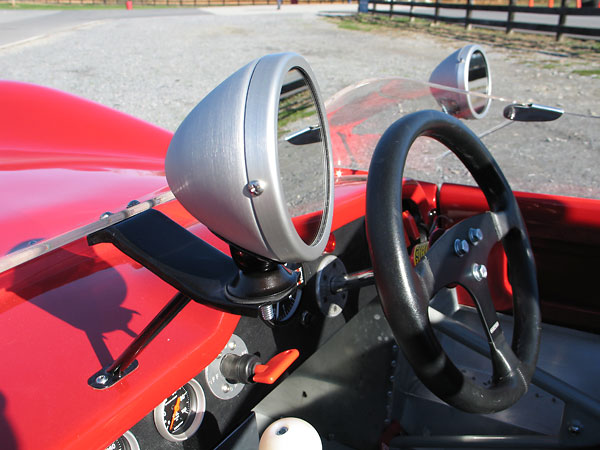
�
Lola Mark One mirror mounting detail.
�
�
Exterior
��
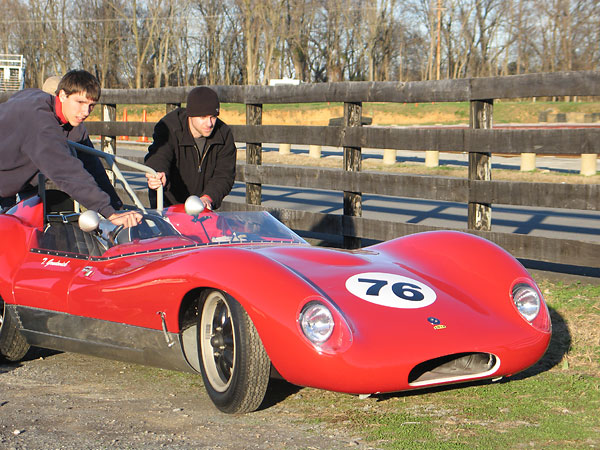
�
The earliest Lola Sports cars came with aluminum bodies, but from 1960 lightweight "cloth construction"
�
fiberglass bodies were provided by Specialised Mouldings.
�
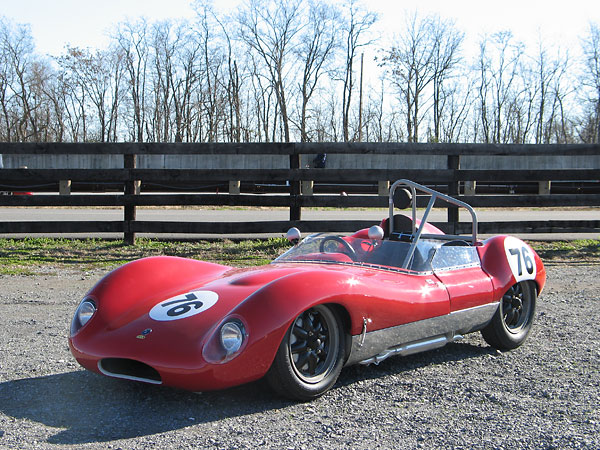
�
By tinting the resin, color was molded into and through the original body panels to provide a durable,
�
high gloss finish without the expense of paint. Lola offered customers a choice of six standard colors.
�
Through its early racing career BR-10 was white with blue accents, followed by an all white paint job.
�
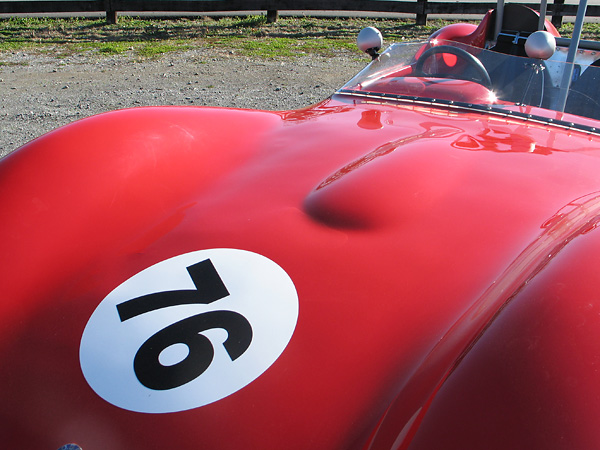
�
76 is the same number that the Lola wore when Ollie Schmidt drove it.
�
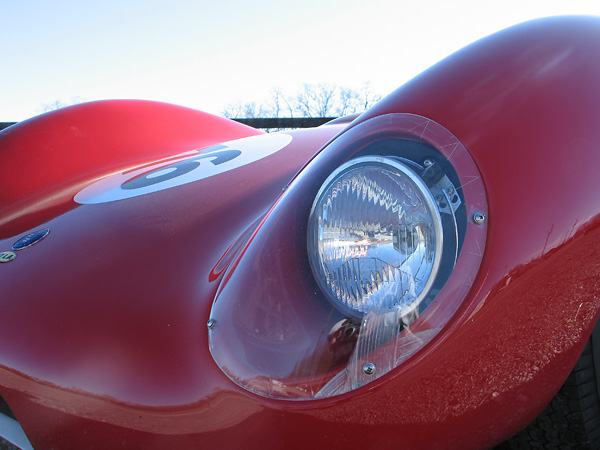
�
Molded perspex headlamp covers maintain smooth airflow and protect the headlamps from stone damage.
�
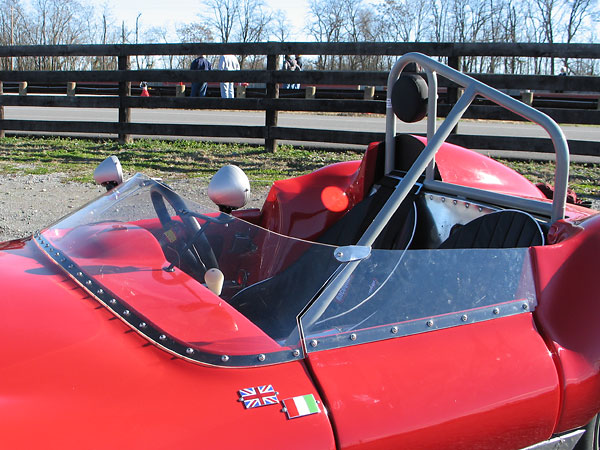
�
A one piece molded perspex (acrylic) windscreen with matching side screens mounted on the doors
�
to align with the contours of the tail. Center support to windscreen also carries rear view mirror.
�
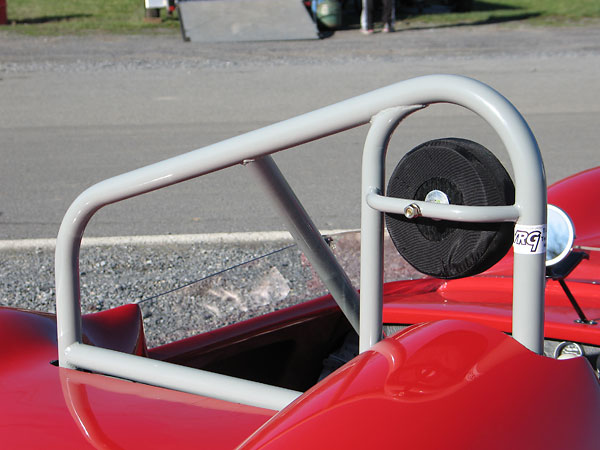
�
The well-braced rollover hoop and headrest are modern additions, as required for vintage racing.
�
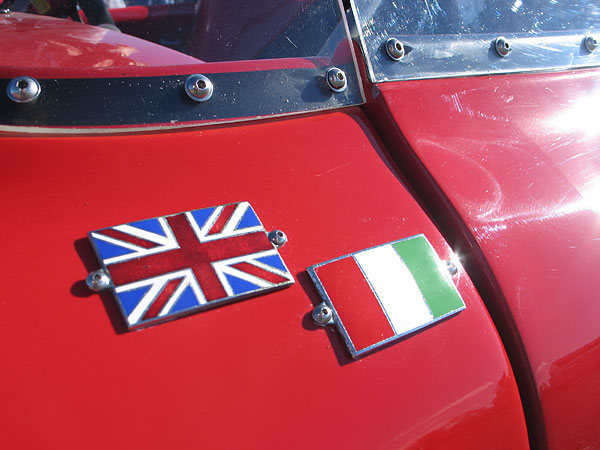
�
English and Italian flag badges.
�
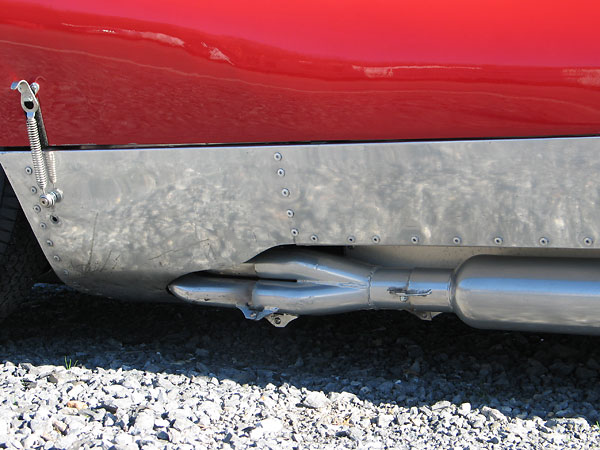
�
A four-into-one header is currently installed, but Lola Mk.1/Climax cars were originally equipped with
�
tri-"Y" (4-2-1) headers. Cylinders 1 & 4 were paired, as were cylinders 2 & 3. The pairings were
�
determined by the engine's firing order. When the OSCA engine was installed, the exhaust exited
�
on the opposite side of the car.
�
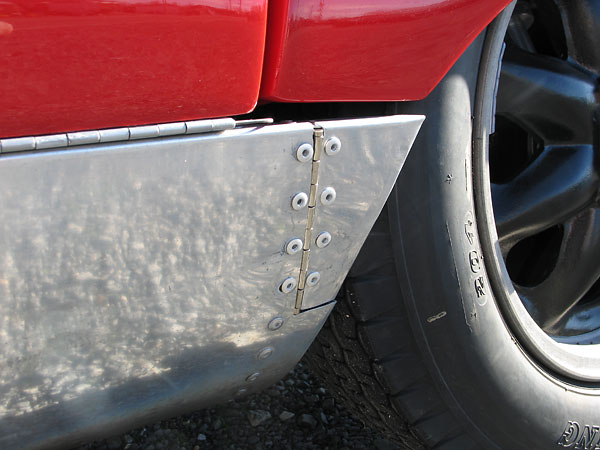
�
These quirky little hinged doors make rear tire changes a little more convenient.
�
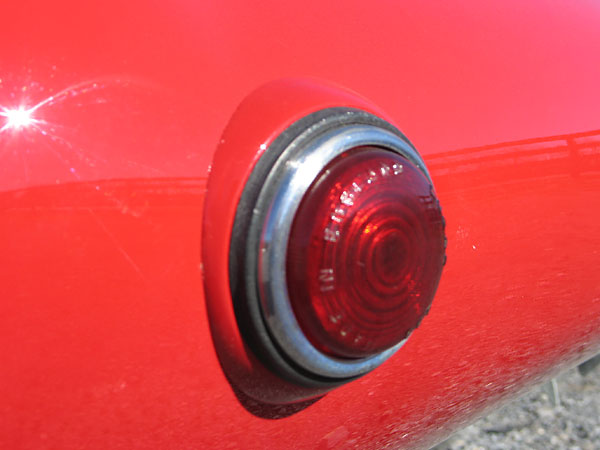
�
Made in England.
�
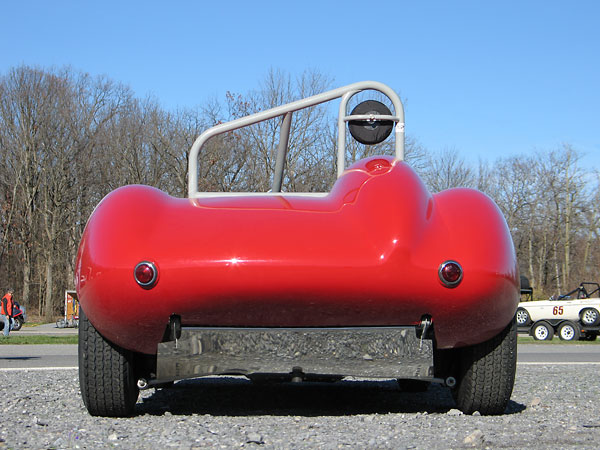
�
Lola Mark One, as typically viewed from a Lotus.
�
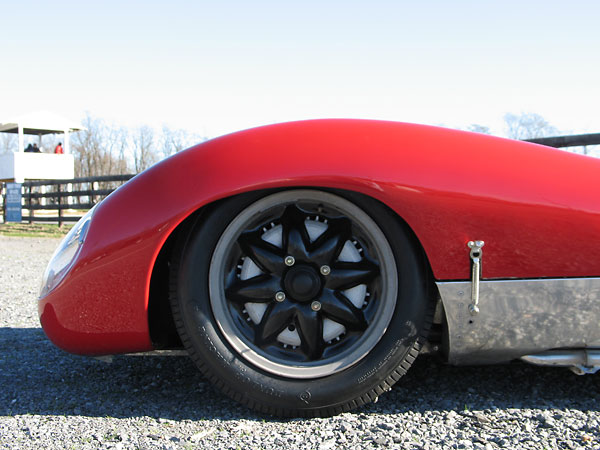
�
Cooper cast magnesium eight spoke wheels (15x5 all around.)
�
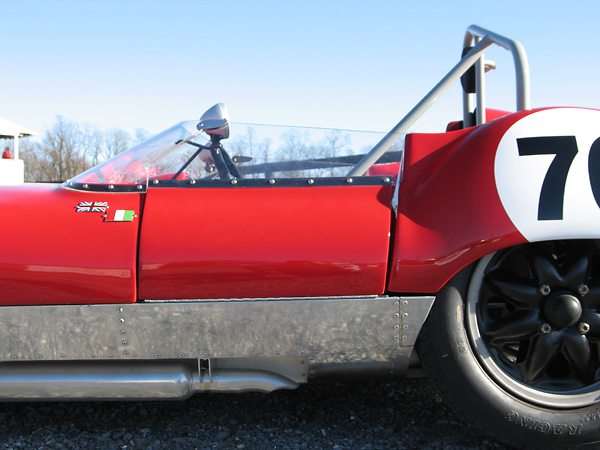
�
Glass pack muffler.
�
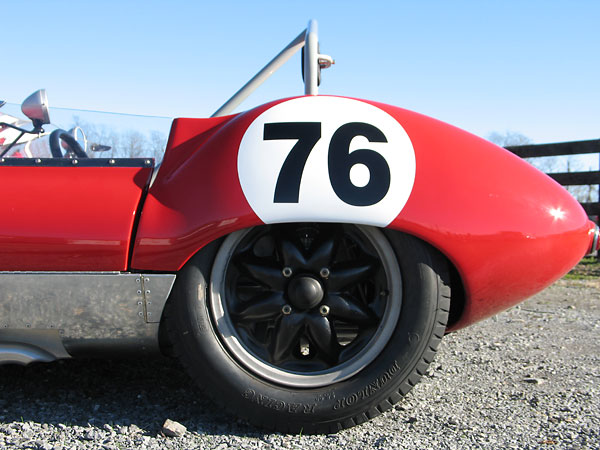
�
Dunlop Racing 204 tires (4.50L-15 front, 5.00L-15 rear).
�
| Notes: | |||||||
| (1) | �
About seven additional Mk.1 cars have existed in some form or other, but accounting is �
complicated because some of the home market cars were sold incomplete or in kit form �
(as opposed to exported cars which were generally sold complete) and because replacement �
frames were offered as a service part. For example, after car BR-11 was wrecked its �
owner bought a spare frame and built it up into a complete car which wears chassis �
plate BR-33. �
� | ||||||
| (2) | �
OSCA was an abbreviation of "Officine Specializzate Costrutzione Automobili", a small company�
founded in Bologna Italy by three of the famous Maserati brothers. The company was founded �
in 1947, ten years after they had sold the original Maserati car manufacturing company. �
OSCA built a series of sports and specialty racing cars and also racing engines through �
1967. Before ordering his Lola, Ollie Schmidt already owned a 750cc OSCA racecar, and with �
it he won the 1960 SCCA H-Modified championship. �
� | ||||||
| (3) | �
Lola Cars Ltd. provided the following rear suspension set-up explanation to their customers: �
"At the outer end of the rear wishbone will be seen three large alloy hexagons, one in front of �
the hub carrier casting and two behind. The rearmost of these three is attached to an eccentric �
bush in the wishbone pivot and by slackening the locknut on the pivot shaft and turning this �
hexagon the wheel can be made to toe-in or toe-out. They should be set up between straight ahead �
and 1/16" toe-in towards the front of the car. To turn the other two hexagons it is also necessary �
to slacken the two Allen screws in the hub carrier casting which lock them in position: when�
turned these two will alter the camber angle of the wheel. The recommended angle is 1 to 1.5 �
degrees negative camber (i.e. leaning in at the top) at the static position including driver's �
weight. The easiest way to obtain this is to jack the car off its wheels taking care to keep �
it level and then adjust the wheels dead upright, when the suspension is deflected this will �
give the required angle. To reduce the angle will make the back of the car slide more easily: �
by increasing the angle the breakaway point will be delayed until a higher cornering speed is �
reached but will then be relatively more rapid and give less warning of approach; for this �
reason we do not recommend that a higher angle than 1.5 degrees of negative camber be used."�
� | ||||||
�
All photos shown here are from November 2009 when we viewed the car at the VRG's Turkey Bowl�
at Summit Point Motorsports Park, West Virginia. Photos by Curtis Jacobson for BritishRaceCar.com, �
copyright 2010. All rights reserved.
�
| If you liked this article, you'll probably also enjoy these: | �|||||
 | �
Jeff Snook '56 Lotus XI LeMans | �
 | �
Michael Oritt '59 Elva Mk1 | �
 | �
Bill Thumel '67 Lola T70 Mk3 | �
| You're invited to discuss anything you've seen here on The British Racecar Motorsports Forum! | �|||||
�
Notice: all the articles and almost all the photos on BritishRacecar.com are by Curtis Jacobson.
�
(Photos that aren't by Curtis are explicitly credited.) Reproduction without prior written permission is prohibited.
�
Contact us to purchase images or reproduction permission. Higher resolution images are optionally available.
�

 �
�